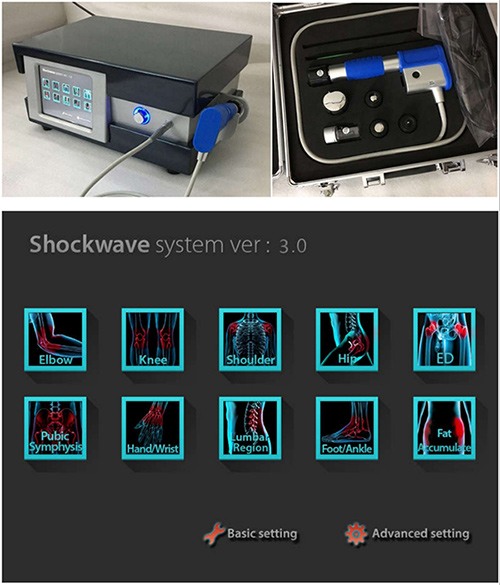Extracorporeal Shockwave Therapy
What is Extracorporeal Shockwave Therapy?
Extracorporeal Shock Wave Therapy (ESWT) is a non-invasive (no cutting of skin and no introduction of any medical device in the body) method of treating soft tissue injuries. Extracorporeal means outside the body. Shock wave is a short energy wave with high intensity, traveling faster than sound. ESWT does not disintegrate tissue; rather it causes biological effects that help in tissue regeneration. ESWT reduces pain and sensitivity immediately by over-stimulating pain transmission nerves. It triggers the repair mechanism of the body by formation of new blood vessels. The shock wave stimulates osteoblasts (bone cells) in the body and promotes bone healing and new bone production.

Extra Corporeal Radial Shockwave Therapy
Radial Shockwave Therapy is used for a number of musculoskeletal disorders including:
- Tendinitis, Tendinopathy and Tendon Tears
- Ligament Injuries
- Delayed Bone Healing
- Chronic Bone Disorders including Osteitis Pubis and Stress Fractures
The therapy was initially used in assisting the removal of kidney stones via external application on the skin. This therapy demonstrated changes in the soft tissues in the skin, muscles and tendons which lead to the use of radial shockwave for tendons and other soft tissues.
Shockwave therapy has a number of roles in treating musculoskeletal disorders, which allows for the immediate improvement of symptoms and in combination with other treatment approaches, can completely resolve all symptoms.
Shockwave Therapy Can Treat:
- Plantar Fasciitis
- Patella Tendinopathy and Tears
- Hamstring Tendinopathy and Tears
- Achilles Tendinopathy
- Calcific Bursitis
- Rotator Cuff disorders
- Trochanteric Bursitis and Gluteal Tendinopathy
How Does Shockwave Therapy Work?
How shockwave works is only partly understood and currently there are a number of studies internationally to assist in further understanding the science behind the results we are see with shockwave therapy.
The current understanding is that the shockwave application causes a release of substance P from the terminal vesicles of nerves which saturate the pain fiber receptors. This causes an overload and blocking effect with an immediate decrease in pain. The nerves that cause pain are effectively “ paralysed” so that patients will do a task that usually causes pain and find that this is almost pain free.
Usually patients require 2-3 treatments. Patients usually have some immediate improvement from shockwave. Then from the second treatment the pain reduces further and by the third session there is a significant decrease in pain, which may longstanding.
Radial shock wave works best when combined with a comprehensive rehabilitation program. We do expect patients to carry out specific strengthening exercises in consultation with a physiotherapists or other practitioner who specialises in tendon rehabilitation for long term results.
Treatment only lasts 10-15 minutes and patients only feel mild discomfort during the treatment.
Post-treatment care for Extracorporeal Shockwave Therapy
You can continue with your regular daily activities immediately after each session. In cases of heel spurs, running should be avoided for a week or more after the second session of ESWT.
Risks and Complications of Extracorporeal Shockwave Therapy
ESWT has no major risks. The most commonly observed minor risks are:
- Pain (energy levels of shock waves can be adjusted to individual’s tolerance levels)
- ESWT is not preferred if you have bone tumours, metabolic bone conditions and nerve or circulation disorders.
- It is not recommended for pregnant women, areas of infection, locations where gas is present in the body and on locations where bone is still growing.
ESWT is considered a safe and effective treatment option for soft tissue injuries.


